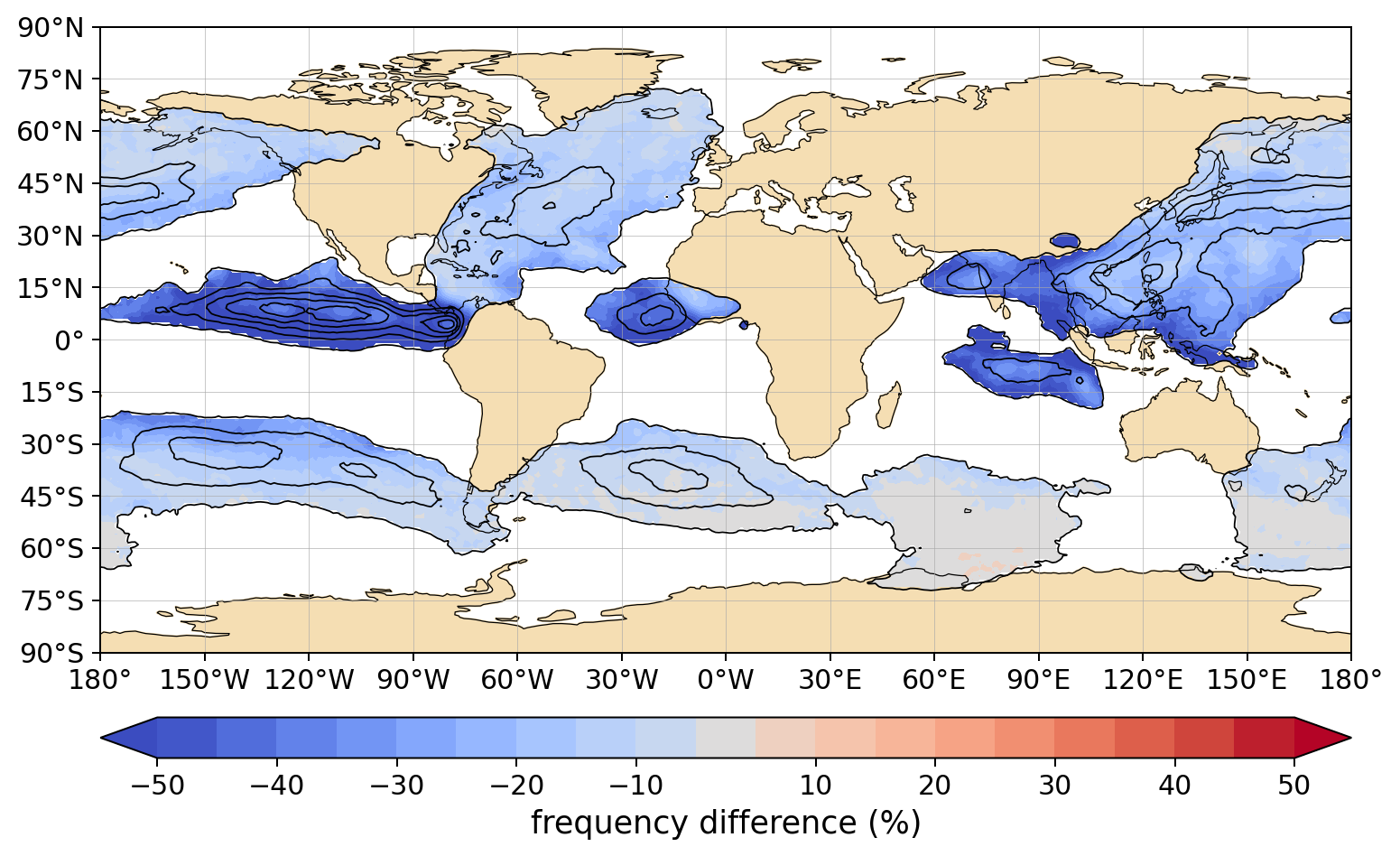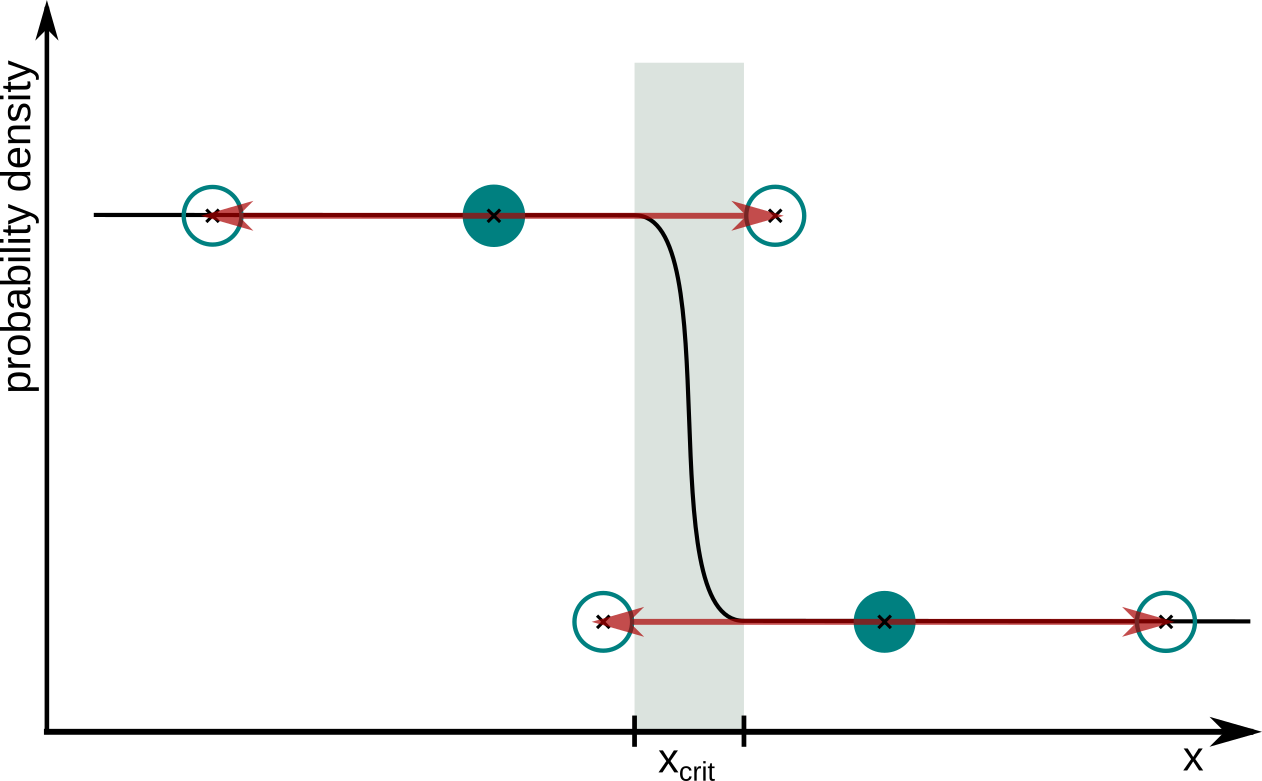One-sided effect of stochastic perturbations in ensemble forecasts on rapidly ascending air streams
Numerical weather prediction (NWP) is subject to uncertainties due to the chaotic behaviour of the atmosphere. In order to take these uncertainties into account, so-called ensemble forecasts are carried out, which calculate not only one, but several possible evolutions of the atmospheric state. The range of predicted scenarios (the ensemble spread) allows an estimation of the forecast uncertainty and, according to the so-called spread-error ratio, also of the forecast skill [1].

Relative differences (colour shading) of the outflow frequencies of rapidly ascending air streams between a reference experiment with SPPT and initial condition perturbations and an experiment without SPPT. Only differences are shown in which the absolute frequency of the reference experiment (black contours of 5% steps between 5 and 25%) is at least 5%. The differences are based on 32 forecasts between mid-August and mid-October 2016 with 20 ensemble members each over 10 forecast days @Pickl et al. 2022
At the European Centre for Medium-Range Weather Forecasts (ECMWF), ensemble forecasts are produced by starting the individual model runs from slightly modified initial conditions, thereby taking into account uncertainties in the estimation of the initial state from meteorological observations. In addition, perturbations are introduced during the simulation to represent the sources of error in the programme code and in the formulation of the forecast model. These perturbations are currently generated using the stochastically perturbed parametrization tendencies (SPPT) scheme. SPPT is designed to introduce perturbations primarily where physical processes occur that cannot be resolved directly by the model [2]. For example, condensation and cloud formation occur on such small scales that even today's "high-resolution" models with grid sizes of 9km and more do not resolve these processes, but must approximate them using empirical relationships (so-called parametrizations).
A weather system that is strongly influenced by diabatic processes is the so-called Warm Conveyor Belt (WCB), a moist-warm air stream that typically ascends from the boundary layer of the warm sector of low-pressure systems into the upper troposphere within 1-2 days. During the ascent, water vapour condenses and latent heat is released. Since these processes have to be parametrized in NWP models, SPPT introduced perturbations of large magnitude in such situations.
In a newly published study [3], which was conducted in the working group "Large-scale Dynamics and Predictability" in collaboration with colleagues at ECMWF, we investigated if and how SPPT affects WCBs and other rapidly ascending air streams that are influenced by diabatic processes, thereby providing a weather system perspective on stochastic perturbations. Our results show that in forecasts with SPPT there are systematically more rapidly ascending air streams without changing their physical properties. The magnitude of this effect depends on how much latent heat is released during the ascent: While in the tropics with SPPT in some cases more than twice as many such air streams occur than in unperturbed forecasts, in the extratropics, where latent heating rates are lower, the value amounts to an increase of about 10-20% (Figure 1). This increase in occurrence frequencies leads to an improvement in the prediction of such air streams, especially in the (sub-) tropical regions, because their frequency is systematically underestimated there. As such rapidly ascending air streams are closely related to the formation of precipitation, SPPT also changes the global precipitation distribution.
With our study, we were able to show somewhat surprisingly that SPPT, despite its symmetric and zero-mean perturbations, has a one-sided effect on the frequency of WCBs and other rapidly ascending air streams. This behaviour is a result of the interaction of the perturbations with non-linear processes characterised by threshold behaviour, e.g. in the initiation of convection (Figure 2).

Schematic representation of the effect of symmetric perturbations (red arrows) in a non-linear system that is unstable above the threshold xcrit. @Pickl et al. 2022
References:
[1] Leutbecher, M. and Palmer, T. N. (2008) Ensemble forecasting. Journal of Computational Physics, 227, 3515–3539. https://doi.org/10.1016/j.jcp.2007.02.014.
[2] Leutbecher, M., Lock, S. J., Ollinaho, P., Lang, S. T., Balsamo, G., Bechtold, P., Bonavita, M., Christensen, H. M., Diamantakis, M., Dutra, E., English, S., Fisher, M., Forbes, R. M., Goddard, J., Haiden, T., Hogan, R. J., Juricke, S., Lawrence, H., MacLeod, D., Magnusson, L., Malardel, S., Massart, S., Sandu, I., Smolarkiewicz, P. K., Subramanian, A., Vitart, F., Wedi, N. and Weisheimer, A. (2017) Stochastic representations of model uncertainties at ECMWF: state of the art and future vision. Quarterly Journal of the Royal Meteorological Society, 143, 2315–2339. https://doi.org/10.1002/qj.3094.
[3] Pickl, M., Lang, S.T.K., Leutbecher, M. and Grams, C.M. (2022): The effect of stochastically perturbed parametrisation tendencies (SPPT) on rapidly ascending air streams. Quarterly Journal of the Royal Meteorological Society. In press. https://doi.org/10.1002/qj.4257.
Junior Investigator Group: "Large-scale Dynamics and Predictability"
